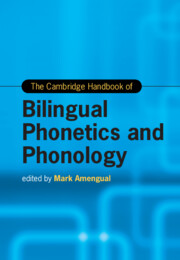Book contents
- The Cambridge Handbook of Bilingual Phonetics and Phonology
- Cambridge Handbooks in Language and Linguistics
- The Cambridge Handbook of Bilingual Phonetics and Phonology
- Copyright page
- Dedication
- Contents
- Figures
- Tables
- Contributors
- Acknowledgments
- Introduction Bilingual Phonetics and Phonology
- Part I Approaches to Bilingual Phonetics and Phonology
- Part II Theoretical Models of Bilingual Phonetics and Phonology
- Part III The Phonetics and Phonology of the Bilingual Child
- Part IV The Phonetics and Phonology of the Bilingual Adult
- Part V The Diversity of Bilingual Speakers
- Part VI Variables and Outcomes of Bilingual Speech
- 29 Language Dominance Effects in the Phonetics and Phonology of Bilinguals
- 30 Code-Switching and Language Mode Effects in the Phonetics and Phonology of Bilinguals
- 31 Orthographic Effects in the Phonetics and Phonology of Second Language Learners and Users
- 32 Phonetic and Phonological L1 Attrition and Drift in Bilingual Speech
- 33 Bilingual Speech Intelligibility
- 34 Using a Characteristic Speech Production (CSP) Procedure to Elicit Monolingual and Bilingual Speech
- 35 Bridging the Gap between Bilingual Phonetic Research and Pronunciation Teaching
- Index
- References
30 - Code-Switching and Language Mode Effects in the Phonetics and Phonology of Bilinguals
from Part VI - Variables and Outcomes of Bilingual Speech
Published online by Cambridge University Press: 14 November 2024
- The Cambridge Handbook of Bilingual Phonetics and Phonology
- Cambridge Handbooks in Language and Linguistics
- The Cambridge Handbook of Bilingual Phonetics and Phonology
- Copyright page
- Dedication
- Contents
- Figures
- Tables
- Contributors
- Acknowledgments
- Introduction Bilingual Phonetics and Phonology
- Part I Approaches to Bilingual Phonetics and Phonology
- Part II Theoretical Models of Bilingual Phonetics and Phonology
- Part III The Phonetics and Phonology of the Bilingual Child
- Part IV The Phonetics and Phonology of the Bilingual Adult
- Part V The Diversity of Bilingual Speakers
- Part VI Variables and Outcomes of Bilingual Speech
- 29 Language Dominance Effects in the Phonetics and Phonology of Bilinguals
- 30 Code-Switching and Language Mode Effects in the Phonetics and Phonology of Bilinguals
- 31 Orthographic Effects in the Phonetics and Phonology of Second Language Learners and Users
- 32 Phonetic and Phonological L1 Attrition and Drift in Bilingual Speech
- 33 Bilingual Speech Intelligibility
- 34 Using a Characteristic Speech Production (CSP) Procedure to Elicit Monolingual and Bilingual Speech
- 35 Bridging the Gap between Bilingual Phonetic Research and Pronunciation Teaching
- Index
- References
Summary
The interaction between bilingual phonetic systems is dynamic, shaped by both long-term and short-term factors. Short-term factors, the focus of this chapter, refer to immediate changes in the linguistic situation. This chapter discusses two short-term sources of potential phonetic interference: code-switching and bilingual language mode. A growing body of research on the phonetics of code-switching has shown that code-switching may result in phonetic interference between the L1 and the L2, although outcomes may vary across speakers and features. Language mode describes a bilingual’s position along a continuum, from operation in a monolingual mode, in which only one language is active, to bilingual mode with equal activation of both languages. Recent work has demonstrated that language mode may modulate cross-linguistic phonetic interference, with greater interference found during bilingual mode. Finally, this chapter discusses two variables responsible for modulating and constraining phonetic interference in cases of dual language activation that have emerged in the literature – the nature of the phonetic feature and bilingual language dominance.
Keywords
- Type
- Chapter
- Information
- The Cambridge Handbook of Bilingual Phonetics and Phonology , pp. 677 - 698Publisher: Cambridge University PressPrint publication year: 2024

